
Manufacturer's Specifications
FM Tuner Section
Mono Usable Sensitivity: 11.2 dBf.
50-dB Quieting: Mono, 20.2 dBf; stereo, 40.2 dBf.
S/N: Mono, 75 dB; stereo, 70 dB.
THD: Mono, 0.2%; stereo, 0.3%.
Frequency Response: 20 Hz to 15 kHz, + 1.0,-2 0 dB.
Alternate-Channel Selectivity: 65 dB.
Capture Ratio: 1.0 dB.
Image Rejection: 50 dB at 98 MHz.
I.f. Rejection: 90 dB at 98 MHz.
Spurious-Response Rejection: 80 dB at 98 MHz.
AM Suppression: 50 dB.
Channel Separation: At 1 kHz, 40 dB; at 10 kHz, 30 dB.
Carrier Leakage: At 19 kHz,-35 dB; at 38 kHz,-50 dB.
AM Tuner Section
Sensitivity: 20 uV; 330 uV/m.
Selectivity: 55 dB.
Image Rejection: 40 dB at 1 MHz.
I.f. Rejection: 60 dB at 1 MHz.
Video Section
Composite Video Output Voltage: 1.0 V peak to peak, ± 0.1 V, for 1 V input.
Maximum Input Voltage: 1.5 V peak to peak.
Input and Output Impedance: 75 ohms, unbalanced.
S-Video Input and Output Voltages: Y (luminance), 1V peak to peak; C (chrominance), 0.286 V peak to peak.
Digital Section Harmonic Distortion: 0.005% at 1 kHz.
Frequency Response: 2 Hz to 20 kHz, ± 0.3 dB.
Amplifier Section
Rated Power: Front channels, 125 watts/channel into 8 ohms, 20 Hz to 20 kHz; rear channels, 30 watts/ channel into 8 ohms at 1 kHz; center channel, 60 watts at 1 kHz.
Rated THD: Front, 0.008%; rear and center, 0.8% at 1 kHz.
Dynamic Headroom, Front Channels: 1.2 dB.
SMPTE-IM Distortion, Front Channels: 0.01%.
Frequency Response, Front Channels: High-level inputs, 7 Hz to 70 kHz, ±3.0 dB; phono, RIAA standard curve, ±0.8 dB.
Input Sensitivity for 1 Watt Out: High level, 27 mV; phono, 0.4 mV.
S/N (re: 1 Watt): High level, 70 dBA; phono, 70 dBA.
Maximum Phono Input Voltage: 160 mV at 1 kHz.
Tone Control Range: Bass, ± 10 dB at 50 Hz; treble,-± 10 dB at 20 kHz.
Four-Band Parametric Equalizer Range: ± 10 dB.
Loudness Compensation at -30 dB: +9 dB at 50 Hz.
Damping Factor, 8 Ohms: 30.
General Specifications
Power Requirements: 120 V a.c., 60 Hz, 500 watts, 650 VA.
Dimensions: 16 15/16 in. W x 6 1/4 in. H x 16 7/8 in. D (43 cm x 15.8 cm x 42.9 cm).
Weight: 33 1/2 lbs. (15.2 kg).
Price: $899.95.
Company Address: One Panasonic Way, Secaucus, N.J. 07094.
Control Layout
This receiver's versatility necessitated the design of a control-laden and perhaps intimidating front panel. Even the most experienced audio enthusiast will need to spend some time consulting the owner's manual--at least during the first week or so of use. That owner's manual, incidentally, contains 75 pages of text and diagrams! A "Power" switch, a pair of speaker pushbuttons, and a stereo 'phone jack are at the extreme left of the panel.
Buttons associated with the parametric equalizer and a button for varying the display mode are arranged to the right of the speaker buttons. The "Display Mode” control selects either bar-graphs or dot outlines of the spectrum-analysis or equalization curves; pressing it for more than 3 S starts a demonstration of the parametric equalizer's capabilities.
Additional buttons further down on the panel take care of turning the parametric EQ feature on Of off, fine-tuning the center frequency of each EQ band, adjusting the slope or Q of each filter, and, finally, switching from the parametric EQ to conventional tone controls. Two rotary controls adjust boost or cut levels in either the EQ or the tone-control mode.
A graphic display shows the selected response curve whenever these controls' settings are changed, reverting to a spectrum analysis of the signal at other times. In addition, the display tells the user the status of just about every control and function of the receiver.
Directly below the display are 10 numbered buttons used in memorizing and selecting AM and FM station frequencies. For presets with double-digit numbers (10 through 30), two buttons must be pressed in sequence--i.e., "1" and "6" for station 16.
Another row of buttons below the presets takes care of various surround functions. These include selecting Dolby 3 Stereo (a three-speaker setup for those who do not wish to employ all five speakers needed for Dolby Pro-Logic), adjusting "Delay Times," and activating a Dolby test signal for adjusting the relative levels of all five speakers for uniform surround.
Larger pushbuttons along the lower portion of the panel take care of program source selection and tape monitoring. The upper right corner of the front panel sports a large, calibrated "Volume" control, a rotary "Tuning" knob, and a "Tuning Mode" pushbutton that selects manual, automatic, or "locked" tuning. This last-named mode prevents accidental detuning of the current station if the rotary tuning knob is inadvertently turned. The AM and FM band selector buttons, an FM stereo mode button, a "Memory Scan" button, and a button for presetting station frequencies are all beneath the volume knob. Further down, at the lower right-hand corner, are a "Loudness On/Off" button, a Dolby "Surround Input Balance" control (to minimize dialog leak age in the surround channel), the "Balance" control, and a set of audio and video input jacks.
The rear panel of the SA-GX910 receiver is almost as densely populated as the front panel. Here are found the optical digital, analog audio, composite video, and S-video jacks corresponding to the inputs and outputs mentioned earlier plus a center-channel preamp-level output, front-channel preamp-out/main-in jacks (normally strapped together), and the speaker outputs--40 jacks in all. Binding posts are provided for the front and center speakers; terminals for the rear speakers are the smaller, spring-loaded type. A coaxial FM antenna connector and AM antenna terminals are at the left end of the rear panel, along with a ground terminal. Also on the rear are a pair of switched a.c. outlets, a speaker impedance-matching switch, the receptacle for the detachable line cord, and a "Remote Control Out" jack. The circular opening for the exhaust fan completes the panel layout.
Measurements
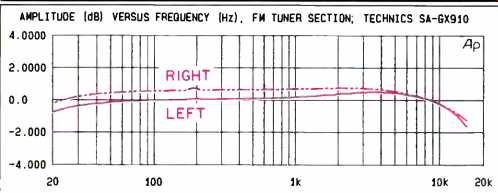
Fig. 1--FM tuner frequency response.
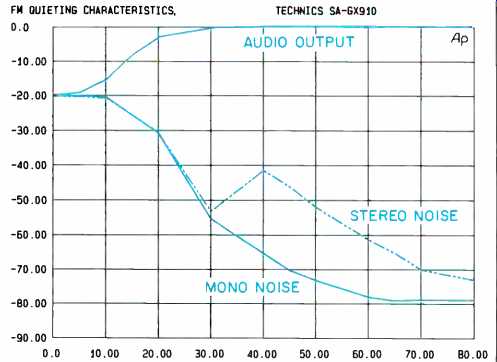
Fig. 2--FM quieting characteristics. Quieting and sensitivity are actually
better than shown; see text.
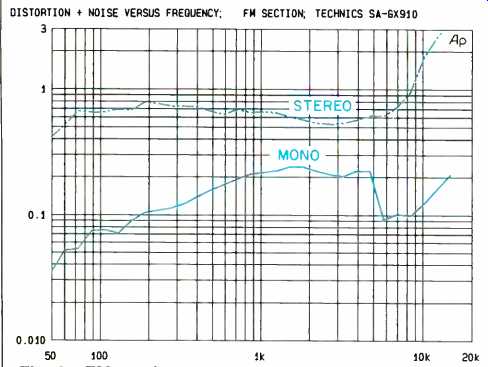
Fig. 3--FM section THD + N vs. frequency.
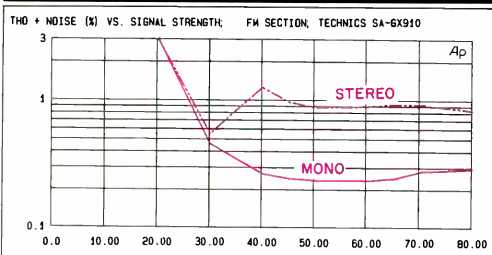
Fig. 4--FM section THD + N vs. signal input level. Usable sensitivity is
actually better than shown; see text.

Fig. 5--Channel separation for 65-dBf FM signal.
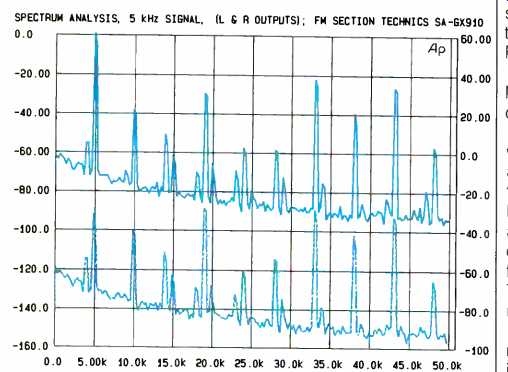
Fig. 6--Spectrum analysis, FM stereo mode, one channel modulated with 5
kHz (top), other channel unmodulated (bottom). Use the right hand scale for
the bottom curve.
As with all receivers that I test, I measured the FM tuner section's performance first. All measurements were made at the front speaker outputs, which listeners use most, rather than at the record outputs. Figure 1 shows the frequency response of the FM tuner section. Response is down 0.6 dB at 20 Hz and 1.7 dB at 15 kHz. There is a marginal difference in level between channels, no more than 0.4 dB at any frequency, with the balance control centered.
Measuring the quieting characteristics of this tuner proved to be something of a problem, because the antenna input's coaxial connector is not the standard U.S. type and I lacked an exact adaptor for it. Technics supplies a 300/75-ohm transformer to fit that connector, but using it also meant that I had to use a second transformer that comes with my 75-ohm signal generator. The two transformers in series introduced a signal loss that I estimate at about 6 dB.
Accordingly, in examining Fig. 2, it is appropriate to subtract 6 dBf from the readings. Thus, while it appears that the 50-dB quieting point for mono occurs at 27 dBf, the correct figure is more like 21 dBf; for stereo reception, the 50-dB quieting point is about 42 dBf rather than the 48 dBf shown on the graph. Ultimate quieting, however, needs no such correction factor: The signal is strong enough at 65 dBf so that no further quieting takes place with stronger signals applied. Best S/N in mono for strong signals is truly around 78 dB, better than claimed by Technics. For stereo reception, S/N reaches the specified 70 dB at an input level of 70 dBf, then increases a bit more, as shown.
Figure 3 shows how THD + N varies with frequency. For mono reception, THD + N at 1 kHz is a bit more than 0.2%, dropping to about 0.1% at 6 kHz and about 0.075% at 100 Hz. Stereo THD + N measures 0.65% over much of the frequency range. Figure 4 shows how THD + N varies with input signal strength. Here again, the losses incurred by my having to use a pair of impedance transformers in series must be taken into account. So, usable mono sensitivity is really around 14 dBf as opposed to the 20 dBf shown.
Channel separation falls somewhat short of published specifications but is adequate for creating a satisfactory stereo image (Fig. 5). Separation is 34.5 dB at 1 kHz, 30 dB at 100 Hz, and 28.5 dB at 10 kHz. However, I soon discovered that this seemingly reduced separation was due to the high level of subcarrier products in the output signals rather than to actual crosstalk of the modulating signals. Consider, for example, the spectrum analysis of a 5-kHz signal that was used to modulate only the left channel. As shown in Fig. 6, the 5-kHz "spike" has an amplitude of 0 dB (the reference level), while the crosstalk at that frequency is at a level of -37 dB, at least 3 dB lower than would be implied by referring to the graph of Fig. 5. Note, too, that the 19-kHz component, in both the modulated and unmodulated channels, is down by only about 30 dB from reference level, and the sidebands at 33 and 43 kHz (5 kHz to either side of the suppressed 38-kHz subcarrier) are also quite large in amplitude. Although all of these subcarrier components are generally inaudible, the high level of 19-kHz output might well have an adverse effect on tape recordings made using Dolby B or Dolby C noise reduction. I was somewhat surprised to see that these high-frequency components had not been effectively attenuated as they are in many other tuners and receivers. On the other hand, I commend Technics for at least specifying the level of 19-kHz carrier leak age pretty realistically as -35 dB. Other measurements made for the FM section include capture ratio, which was 1.5 dB; selectivity, which was 67 dB; image rejection of 55 dB, and AM suppression of 52 dB.
The less said about the performance of this receiver's AM section the better. With so much effort on the part of AM broadcasters to improve their signals (if not their program content) and to comply with recent NRSC standards, it is surprising to me that makers of superb receivers such as this one still pay virtually no attention to AM performance.
Figure 7 shows how poor the AM frequency response is; the -6 dB attenuation points occur at 80 Hz and 3.3 kHz. The NRSC standards dictate that response should be within ±3 dB of flat out to 7.5 kHz! Enough said.
Preamplifier and amplifier measurements for this receiver were made via the CD inputs (with the exception of phono and direct digital input measurements). Figure 8A shows the frequency response obtained using the analog CD inputs.
Response is down by barely 0.5 dB at 20 Hz and by 0.4 dB at 20 kHz. At 50 kHz, response is down by 1.5 dB. Frequency response was also measured by feeding digital signals from my test system to the SA-GX910's optical digital input.
The results, shown in Fig. 8B, do not differ in any great respect from those obtained via the analog inputs.
Using the equalizer's tone-control mode, I next plotted the range of the bass and treble controls, and results are shown in Fig. 9. Note that midrange frequencies are only minimally affected even when the bass and treble controls are turned to their extreme boost or cut positions. This, to my mind, has always been the preferred approach to tone-control design.
Switching to the parametric equalization mode, I set up an admittedly arbitrary (and no doubt exaggerated) response curve just to see how flexible the parametric EQ circuitry is.
My test curve (not shown) had a sharp peak at 100 Hz, a sharp dip at about 1.6 kHz, and a broad peak from 10 to about 17 kHz, followed by a slope that was down to -15 dB at 80 kHz.
Checking the loudness compensation next, I saw that Technics has wisely confined the action to the bass region only. The amount of bass boost varied smoothly, from just a couple of dB at volume settings of -10 dB to the full +9 dB at settings of-30 dB and lower.
Turning to the power amplifier sections for the front speakers, I next measured THD + N versus frequency for the rated output of 125 watts/channel into 8-ohm loads (Fig. 10). Over much of the frequency spectrum, THD + N is around 0.01% at this high power output level, but at low frequencies, THD tends to rise, reaching a still insignificant level of 0.068% at 20 Hz. Good correlation with these results was obtained when I plotted THD + N versus power at 20 Hz, 1 kHz, and 20 kHz. The results (Fig. 11) are nearly identical for the 1- and 20-kHz test frequencies but show a higher level of distortion at 20 Hz.
In order to isolate actual distortion components from residual noise, I used the FFT spectrum-analysis facilities of my Audio Precision test equipment to display the harmonic components associated with a 1-kHz signal at rated output of 125 watts. The significant harmonic components were at 2 and 3 kHz, with much smaller harmonic components visible at 4, 5, 6, and 7 kHz. The most significant component (3 kHz) was 81.9 dB below reference level, which corresponds to a true THD value of 0.008%, precisely the value specified by Technics. As to SMPTE-IM distortion at rated output, it was 0.023% for the left channel and 0.025% for the right channel.
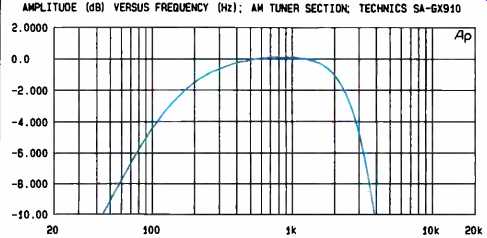
Fig. 7--AM section frequency response, using 75-µS pre-emphasis and de-emphasis.
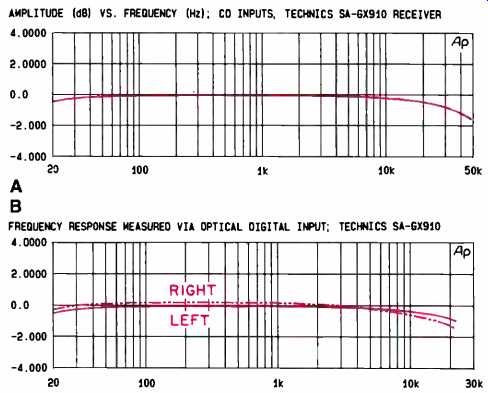
Fig. 8--Frequency response, at front speaker outputs, for analog signal
via CD inputs (A) and digital signal via optical input and receiver's internal
D/A converter (B).
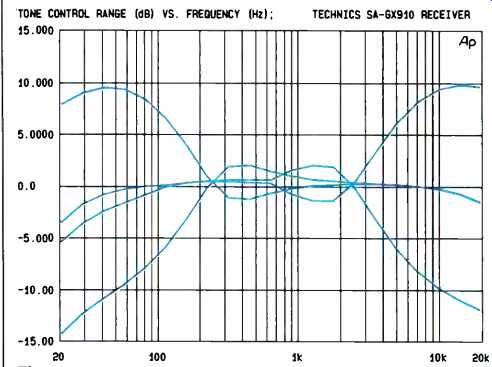
Fig. 9--Bass and treble control range.
Signal-to-noise ratio for high-level inputs, referred to 1 watt output with an input of 500 mV, measured -76 dBA for the left channel and -75.1 dBA for the right. These results may be compared directly with the published specifications, since Technics quotes all of their amplifier specifications in accordance with the IHF/EIA Amplifier Measurement Standards adopted in 1978. (Would that more manufacturers would do so!) A third-octave spectrum analysis of residual noise (again referred to 1 watt output) showed noise peaks of about -90 dB at the 60-Hz power-line frequency and its harmonics of 180 and 300 Hz; otherwise, the curve sloped from about-108 dB at 30 Hz up to about -82 dB at 20 kHz. For the phono inputs, for a volume setting that produced 1 watt from a reference input of 5 mV, S/N with the signal removed and input jacks shorted was -75.9 dBA for the left channel and -75.2 dBA for the right.
Sensitivity for the high-level inputs measured 24 mV for 1 watt output, while for the phono inputs, the signal required to produce the same output was 0.29 mV at 1 kHz. Applying an RIAA-equalized signal to the phono inputs produced the frequency response curve shown in Fig. 12. Deviation from correct RIM playback equalization is negligible from 20 kHz down to around 50 Hz. Below this frequency, Technics elected to use the IEC playback curve (which attenuates response below 50 Hz to reduce the effects of turntable rumble) rather than the RIAA curve.
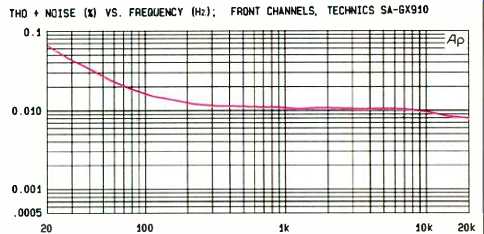
Fig. 10--Front-channel amplifier THD + N vs. frequency, at rated output
(125 watts/channel into 8 ohms, both channels driven).
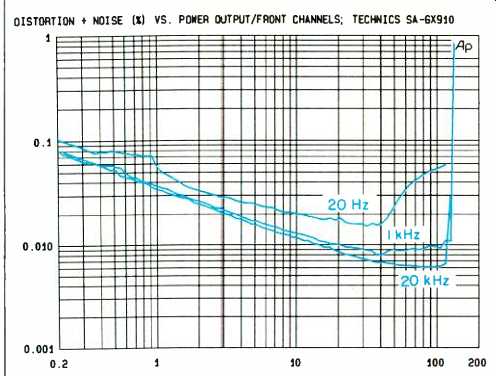
Fig. 11--THD + N vs. power output for front channels.

Fig. 12--Deviation from RIAA equalization; see text.
Use and Listening Tests
As I have stated in previous reports; it is difficult to graph frequency response for the center and surround channels because of the time delays in surround and ambience decoding circuitry. Accordingly, the most meaningful evaluation of surround sound circuits lies in listening and in hooking the component up to a complete home entertainment system, including a large-screen TV, a VCR or two, a videodisc player, and the appropriate number of loudspeakers (in this case, five). That's precisely what I did, and the results were extremely satisfying.
The receiver's remote control truly allows you to clear your coffee table of all those other remotes. Just about everything I wanted to do (short of loading my VCR and videodisc player) was accomplished from the comfort of my easy chair. I can't think of another high-powered receiver that offers so much control and flexibility. My "home theater" has always suffered from a bit too much high-end brilliance, owing to wood paneling that was there long before I converted the room to a home theater. Being able to tweak the response with the top band of the SA-GX910's parametric equalizer really tamed that high end in a manner that is not possible with an ordinary treble control. I had a great time just listening to some of my latest CD acquisitions from Telarc, notably the Cleveland Quartet's rendition of Dvorak's Quartet No. 12 (CD-80283) and Mahler's Eighth Symphony, beautifully performed by the Atlanta Symphony Orchestra and Chorus under Robert Shaw's direction (CD-80267). If some CDs are criticized for an overly brilliant high end, such was not the case once I adjusted the parametric equalizer to take the edge off the room's highs.
The real thrill came when I integrated video viewing with listening. A recent limited-edition LaserDisc from Pioneer and Sports Illustrated, called On the Edge, contains footage shot around the world to provide viewers with the excitement of adventure from the athlete's point of view. There's everything from windsurfing to hang gliding and bobsled ding. The thrills are augmented by the Dolby Surround soundtrack, properly reproduced by this receiver and my five loudspeakers. Then, to calm the spirit and come down from the visual and aural "high," I watched and listened to a Sony Classical LaserDisc, The Loves of Emma Bardac. This imaginative French Impressionist musical docudrama, originally shot in 1,125-line, 60-frame/S high-definition video, intertwines no less than seventy 19th-century Impressionist paintings with music by the duo pianists Katia and Marielle Labeque. As the music was not recorded in Dolby Surround, I used the receiver's "Hall" surround mode to advantage while watching this enchanting video.
To have created such a complete electronic entertainment package in a single component was, I am sure, no easy task for the engineers at Technics. They have done a remarkable job and produced a receiver at a price that should prompt many audio enthusiasts to go the whole route toward a home theater system. The Electronic Industries Association has been sponsoring a series of exhibits de signed to convince consumers that home theater need not involve an investment of $30,000 or more. Technics' SA GX910 receiver goes a long way toward corroborating the EIA's message.
-Leonard Feldman
(adapted from: Audio magazine, Jul. 1992)
Also see:
Technics SA-GX770 A/V Receiver (Jan. 1995)
Technics SU-A8 Preamp and SE-A7 Power Amp (May 1982)
Technics SL-P3 Compact Disc Player (Equip. Profile, Aug. 1985)
Technics SL-P8 Compact Disc Player (April 1984)
Technics SL-P1200 Compact Disc Player (Dec. 1987)
Panasonic Hi Fi Discrete 4-Channel System (ad, Feb. 1973)
= = = =